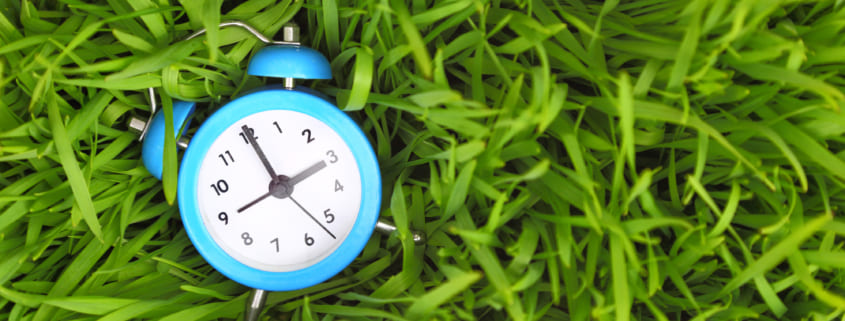Everyone wants to have a lush lawn for their yard, but it can be challenging to obtain. You need more than sun and water to achieve green grass. Those who have beautiful lawns know that the right fertilizer, grass seed, and aeration techniques make the difference. Another critical factor is the time of year that the grass seed is planted. However, the type of grass seed and the time to plant can vary from species to species. Here are a few things to know about planting your grass seed at the right time.
Types of Grasses
Most grasses are divided into two categories: cool-weather and warm-weather grasses. Cool-weather grasses include Kentucky bluegrass, rye, and fescue. Bermuda, St. Augustine, and Zoysia are all warm-weather grasses. These grasses grow better in certain climates. For the cool-weather grasses, they can thrive in chilly summers and winters, while warm-weather grasses grow better in places with warmer summers and winters.
If you do plant grass seeds in an inhospitable environment, you will have to do some extra work to maintain the lawn. Some of this work might include reseeding the entire yard.
U.S. Grass Climates
If that didn’t complicate matters enough, the United States National Arboretum has divided the country into four different climate zones. They include cool/humid, cool/arid, warm/humid, and warm/arid regions. These turf zones can help you to choose the right grass seed for your location. Most of Pennsylvania is located in the cool/humid zone, with the southern portion of the state in a transitional region.
Fall for Cool Season Grasses
These cool-season grasses grow best in the cool temperatures of the late summer and early autumn seasons. They can flourish throughout the northern climate, including the transition zone, where the warm and cool regions overlap.
Fall is the best time to plant cool-season grasses. In autumn, the soil is still warm enough from the summer sun. With a combination of moderate day temperatures, warm soil, and cool evenings, the grass seeds will germinate faster and establish those new grass seeds.
The best soil temperatures for cool-season grass are between 50°F and 65°F, and the daytime air temperature ranges from 60°F to 75°F. If you want to make sure you have the right temperature, a soil thermometer can help take out any guesswork.
For most people, you need to plant cool-season grass seeds at least 45 days before the first frost. Once the air and soil temperatures drop, the grass seeds have less favorable levels for growth. When planted at this time, your grass will enjoy a full season of fall, along with a second cool growing season in the spring.
These newly planted seeds require consistent soil moisture, and the fall season can be beneficial for their growth. Fall also brings more precipitation, which can lessen the chances of drying out the seeds.
If you cannot plant in the fall, then the spring is another good time. You want the soil and the air temperatures to warm back up. However, you need to watch out for late snowstorms and spring rains, which can keep the soil wet and cold. During this season, the grass has less time to settle in before the high temperatures of the summer.
Spring Planting for Warm Grasses
Warm-season grasses thrive during the warmer temperatures of late spring and early summer. You can find these grasses in the southern and western regions, including the transition zone’s southern area.
Warm-season grasses germinate when the soil reaches 65°F to 70°F in temperature. By planting in the late spring and early summer, these grasses can enjoy the warm earth and seasonal rains, which can help keep moisture during the germination and establishment processes.
You want to wait until the danger of frost has passed and the soil starts to warm up. Wet and cold soil can lead to rotting seeds, poor germination, and disease. If you wait until the fall season, you need to plant the grass seed at least 90 days before the first fall cold front. This timeframe will give the seeds enough time to establish before the harsh winter.
Many of the seedlings will go dormant when the temperatures drop to near 55°F. The late-seeded grasses are also unable to prepare for harsh conditions. Warm-season grass seed gets a boost from the warmth of summer and a full season of active growth before the winter dormancy. However, there is one exception for spring seeding. Perennial ryegrass can be added for a temporary color for the winter. If you want to add some more green, then you need to seed in the fall season.
Whether you choose to grow warm or cool-season grasses, you need to sow during the natural peak period for the seed to provide the best chances of germination and establishment. With this timing in mind, you can get your seed off to a good start for a healthy and prosperous lawn.
When to Plant in Pennsylvania?
Bluegrasses, ryegrasses, and fescues can all grow in Pennsylvania. This state’s cool summer, high humidity, and cold winters create challenging conditions for lawn grasses.
Pennsylvania has a climate more favorable for cool-season grasses. Bluegrass and fescue thrive in the warm days and cool nights of the spring and fall, while warm-season grasses might struggle with the heat of the summer. Many summer grasses are not recommended for the Pennsylvania area.
The best time to plant your grass seeds in Pennsylvania is in the late summer and early fall. You want to plant no later than October. When you follow this schedule, your grass will benefit from two cool growing cycles in the fall and spring before the scorching summer heat settles into the area.
Whether you have a warm-season or cool-season grass, make sure to choose the right time to plant. By doing this, you can increase your chances of growing a healthy and green lawn.
If you want to know more about lawn care, make sure to fill out the contact form.

